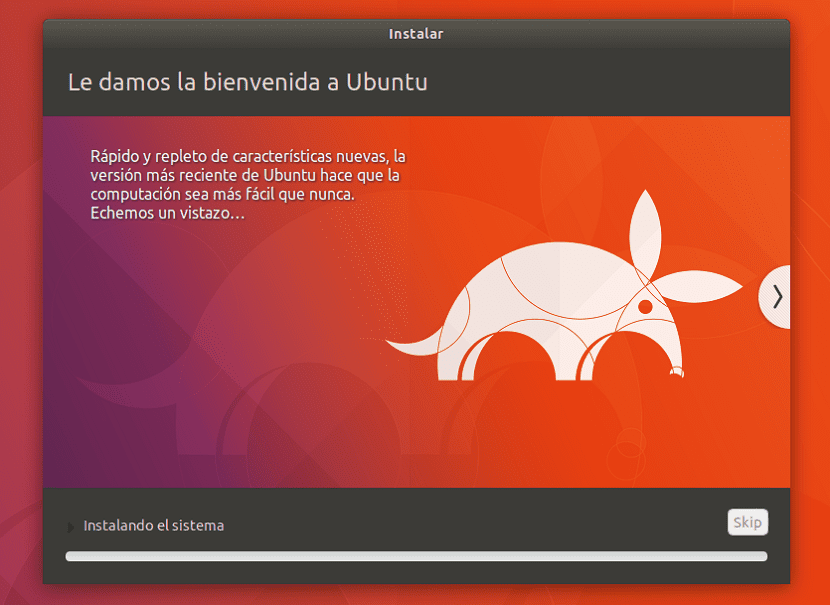
After a launch with a last minute bug which has already been resolved, We can now download the new version of Ubuntu 18.04 LTS Bionic Beaver from the official Ubuntu website. As most of you know, the LTS versions of Ubuntu have a longer support than a regular release.
This is what makes these new LTS versions more anticipated, without further ado we are going to share with you a small guide that is focused on newbies and newcomers to this great system.
It is important to mention that to follow this guide I must assume that you have the basic knowledge to know how to burn a DVD or mount the system on a USB, in addition to knowing how to edit the options of your BIOS to boot the system and in case of having UEFI know how to disable it .
First of all, we must know the requirements to be able to run Ubuntu 18.04 LTS on our computer and I must mention that Ubuntu abandoned the support for 32 bits so if you don't have a 64-bit processor you won't be able to install this new version.
Requirements to install Ubuntu 18.04 LTS
Minimum: 700 MHz 64-bit processor, 1 GB of RAM, 10 GB of hard disk, DVD reader or USB port for installation.
Ideal: 1 GHz x64 processor onwards, 2GB of RAM memory onwards, 20 GB of hard disk, DVD reader or USB port for installation.
Ubuntu 18.04 installation step by step
We must already have the ISO of the downloaded system to be able to record it in our preferred medium to perform the installation, if you have not downloaded it you can do it from the following link.
Prepare Installation Media
CD / DVD installation media
Windows: We can burn the ISO with Imgburn, UltraISO, Nero or any other program even without them in Windows 7 and later gives us the option to right click on the ISO.
Linux: They can use especially the one that comes with the graphical environments, among them are, Brasero, k3b, and Xfburn.
USB installation medium
Windows: They can use Universal USB Installer or LinuxLive USB Creator, both are easy to use.
Linux: The recommended option is to use the dd command:
dd bs = 4M if = / path / to / Ubuntu18.04.iso of = / dev / sdx && sync
Our installation medium is ready we proceed to insert it in the equipment where we are going to install the system, we boot the equipment and the first screen that will appear is the following one, where we are going to select the option to install the system.
Installation Process
It will start to load everything necessary to start the system, done this The installation wizard will appear, where the first screen will ask us to define our language and we give the option to install.
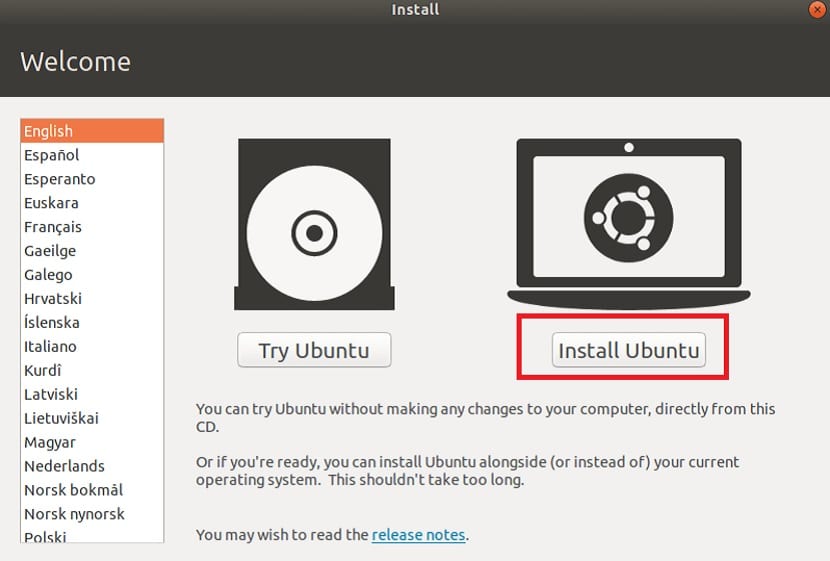
Later in the next screen will give us a list of options in which I recommend selecting to download updates while we install and to install third-party software.
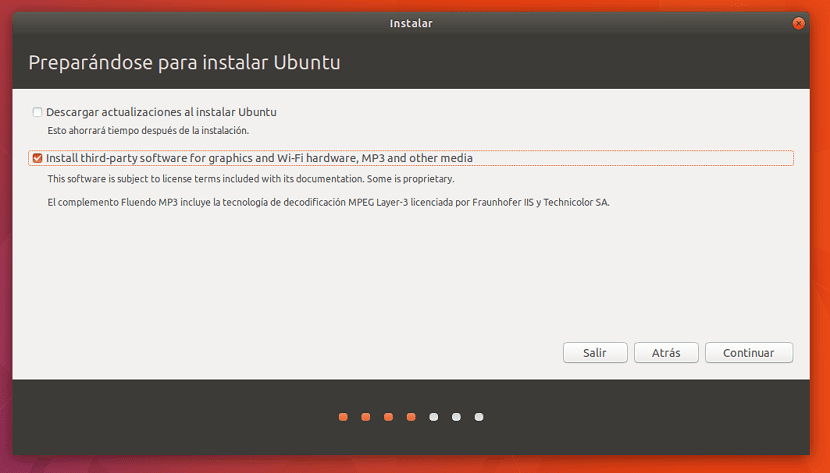
Continuing with the process, it will ask us to choose between the minimum installation or a regular installation, where the first will only have the web browser and basic options and the other will have more tools added such as the office suite.
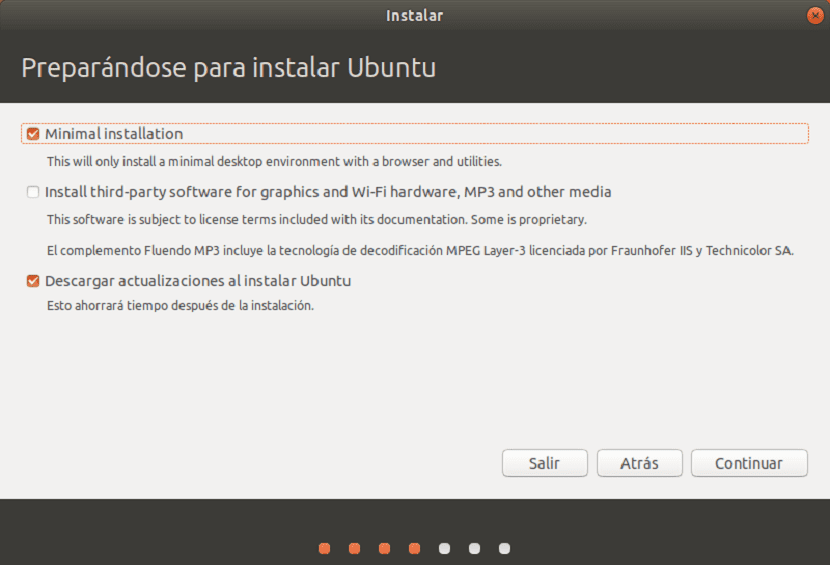
Once the type of installation has been chosen, going on to the following We will now be asked to choose where we will install the system between what we will choose:
erase the entire disk to install Xubuntu 17.10
More options, it will allow us to manage our partitions, resize hard disk, delete partitions, etc. The recommended option if you don't want to lose information.
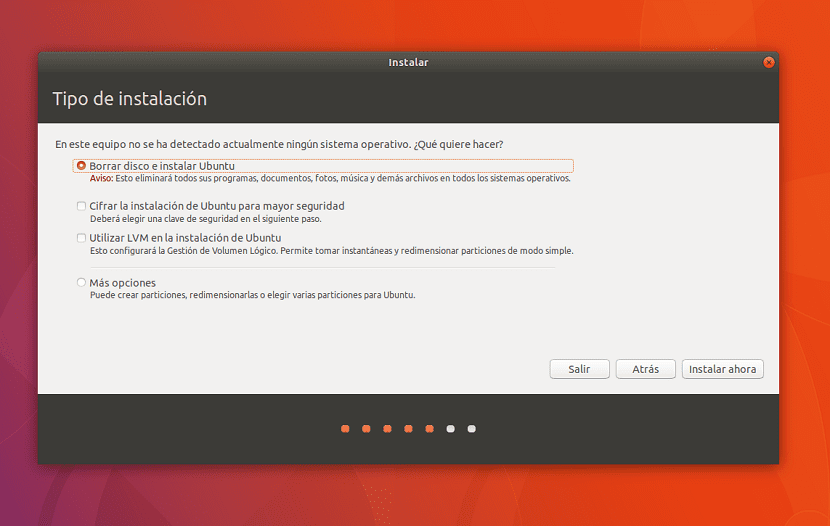
Take into account that if you choose the first one, you will automatically lose all your data.
In the second option you will be able to manage your partitions to be able to install Ubuntu.
Done this process, now we will be asked to choose our time zone.
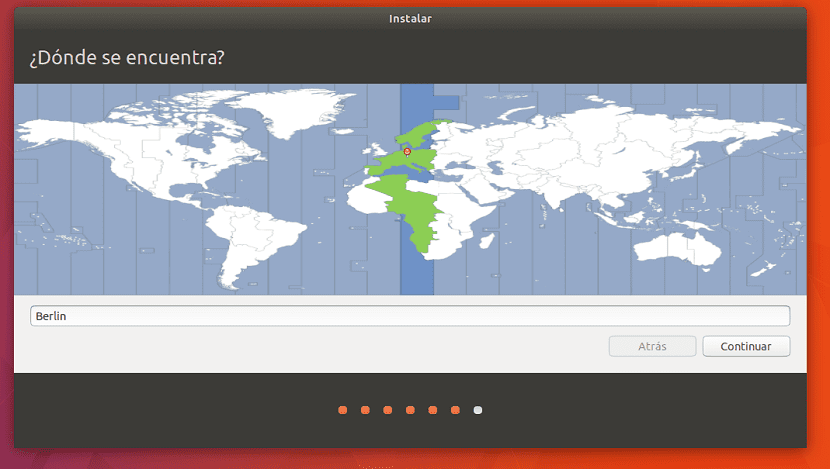
Finally, it will ask us to configure a user with a password.
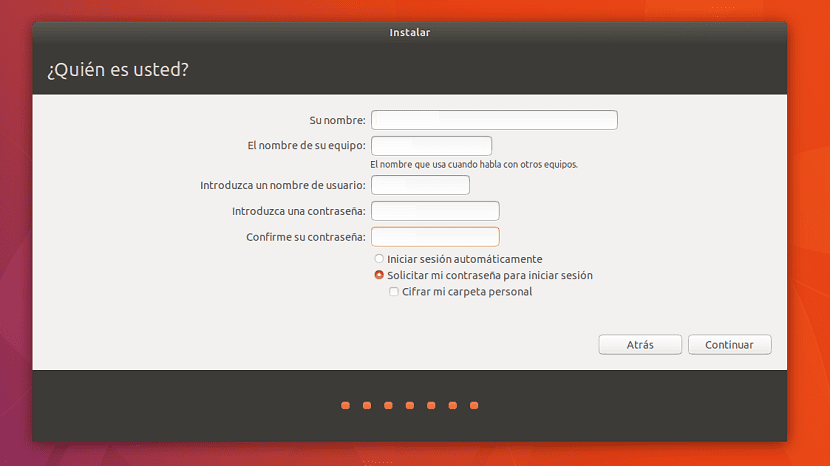
After that, the installation process will begin and we just have to wait for it to finish to be able to remove the installation media.
Now you just have to restart your computer to start using this new version of Ubuntu on your computer.
Hello, thank you very much for the information. Currently I have ubuntu mate 16.04 LTS, I will wait as you say, for stability a few months (or half a year) to install the 18.04LTS. My question is if my computer can continue with ubuntu mate. It is a dell inspiron 1520, whose specifications are:
Intel Core 2 Duo T5250, NVIDIA GeForce 8400M GS - 128 MB, Core: 400 MHz, Memory: 400 MHz, DDR2 RAM Memory 1024 MB, DDR2 PC5300 667 MHz, 2x512MB, max. 4096MB Motherboard
Intel PM965 Hard Drive 120 GB - 5400 rpm, Hitachi HTS541612J9S SigmaTel STAC9205 Sound Card
I would appreciate any help from you, since I consider myself quite a novice. Thank you very much for the contributions !!!
With those features of the machine I would migrate to a lighter option being Xubuntu or Lubuntu better. Well, the main problem of that machine is the GB of RAM. With Lubuntu and not to mention Puppy would fly.
regards
I'm surely going to try it, but for now I'm going to stick with 16.04, which works very well for me.
Almost everyone who uses LTS versions waits for the new LTS and installs version XX.XX.1, to ensure that it does not contain problems, that is, I would recommend waiting for 18.04.1.
Luck
Best regard
I just installed ubuntu 18.04. When I provided it in liveCD, everything worked perfectly, but when I installed the connection to my Wifi network appears, but it does not load any page. I need help to fix it. Thanks
The advanced form of installation does not work. Hard disk without Windows, root, swap, home, and other backup partitions mounted on / media / user / backup
I have tried several various USB, delete partition table, delete partitions. Nothing works. It always throws this error: "grub-efi-amd64-signed failed installation"
I do not know what else to do. Does anyone have any idea how to fix it?
The normal installation works, but I can't partition the disk to my liking.
regards
Unfortunately and tried to install the new Ubuntu both Ubuntu and Ubuntu Mate, they both give me a very serious error, it happens that when installing the system when I am going to log in for the first time it does not let me enter, it tells me that the password is incorrect. which is not like that, and sometimes it manages to start the system but it closes itself and returns to the login and asks for the password again, it does it randomly and in a loop, there was no way to use either Ubuntu or Ubuntu Mate, I hope solve it in the near future, my experience has been terrible, my Hardware has an i7 6700k and a GTX 1070, maybe it is incompatibility with the Hardware.
how bad did the 32bits leave out?
I installed this new version of Ubuntu from Ubuntu 17.10 and I cannot enter the graphical version, it starts from the terminal. I start it by putting the startx command and the graphical environment begins. How can I solve the problem and start it from the graphical environment?
Thank you
I installed 18.04 but enter through recovery mode… ..I cannot enter through default gnome interface…
I had problems with Ubuntu 18.04, my wifi does not detect me and to install the firmware I need to update the kernel to 4.17 rc2, hopefully they will update everything soon because with 16.04 no problem
My problem is that when I restart, in the root screen that appears when starting, before entering ubuntu it tells me ubuntu 18.04 is going to start and it tells me user and password, I put it and it tells me 0 new packages 0 packages are going to update, then I get something like my desktop name with dollar symbols $ and with a space to put something, I put the password and it does not accept me, then I put yes and the letter y appears repeated a thousand times and from there it does not happen , a thousand apologies for my ignorance but it really hasn't happened to me, please help me ...
Responding to user GEN:
Regarding the reference "grub-efi-amd64-signed failed installation" which gives an error, it also happened to me, and it is that from version 18.04 if we manually install the partitions, apart from creating a partition "/" (root where OS is located) I like to create a separate "/ home", now "/ boot / EFI" should not be missing in a Primary partition in FAT32 with 200MB of space, without forgetting a 5GB SWAP (it can range from 2 to 5 depending on our RAM, my advice is a loose SWAP).
Good morning dear, I have a situation with Ubuntu 18.04, I installed it on a desktop pc a bit old: AMD processor at 1.7, 2gb of Ram and 500 of dd, 2gb swap, everything has been fine but lately it has become slow, mainly when I start YouTube in the Google Chrome browser or start some programs, in the System Monitor the CPU values go to the top and occupy the total RAM; Will it be enough to increase the RAM to 4gb to improve performance? also the video card is a nvidia geforce 7300 se / 7200 gs, it is working with a generic diver, I can't find its driver, what can I do?
Good morning community ubunlog.
I am curious to switch to Ubuntu, since I have been told that it runs better than W10 (being that it makes me somewhat slow). Should I install this version? I have a HP 15-bw014la laptops with amd a9-9420 radeon r5 processor specifications, compute cores 2c + 3g 3.00 ghz, and 4 gb ram memory. Thanks in advance for your help 🙂
So much throw KK to the windows and it turned out the same crap this version 18.04. I always believed that linux asked for fewer requirements than windows
Hi carlos.
The thought that Linux is for computers with fewer resources is wrong, since everything depends on the desktop environment, as well as the configurations of this. You can get good performance at fewer resources if you use environments like XFCE, LXDE or window managers such as Openbox.
I just updated my Ubuntu 16.04 to 18.04 and here I am, it works wonderfully well, without problems, it recognized everything, I am very happy also because it kept my Mate environment and all the programs I had.
For those who haven't, this is what I did:
First I updated the version I had
$ sudo apt-get update
$ sudo apt-Get upgrade –yes
$ sudo apt-get dist-upgrade –yes
Then: $ sudo do-release-upgrade
And finally: $ sudo do-release-upgrade -d
Of course, I left the PC on all night because my Internet service is really very bad and the next day I configured everything following a very easy guide.
Then, when it was necessary to restart I had a problem and the desktop did not appear, so I remembered to press Ctrl + Alt and F1. There I was waiting for a console that asked me for the user and then the password. After logging in I wrote: sudo "apt-get update" and then sudo "apt-get upgrade"
In this way they updated and installed a number of packages and programs that had probably failed previously and in the end I put "reboot", it restarted and boilá !!! everything was going wonderfully well.
I hope I have helped someone. Greetings
I have a problem, I installed on a Ubuntu 18.04 lts computer and well, I installed it on the other computer and it presents me with a problem that I have not been able to solve, «when starting it loads well, but it comes out with a double screen or bigger and it does not reflect on the monitor the insert password bar »it's my turn blindly, everything else is fine.
How do I fix that so that the lock screen appears well? If at the time of entering I already configure the monitor screen.
Hello,
I have installed ubuntu 18 on a computer where I already had 16
I first tried the update but it didn't work, the screen was going black.
When installing ubuntu 18.04 from the usb it told me that it was already installed. Anyway I installed it with a partition as recommended.
I went through all the steps, I restarted and it seemed that everything was ok, but when I turn off the computer and turn it on again, Ubuntu loads but the screen stays black, it doesn't even ask for the password
That does it on all 32-bit computers, the architecture with Ubuntu 18 must be 64-bit
Best regard.
I have a Lenovo C365 All-in-One 19 ″ PC
Processor: Processor AMD -6010 APU with AMD Radeon R2 Graphics 1.35 GHz
Ram memory: 4Gb
Hard Drive: 500Gb
I have doubts with the processor since it is a bit old to install Ubuntu 18.04 LTS.
Thank you ..
Hello, can you install ubuntu on intel processors, eg on I7?